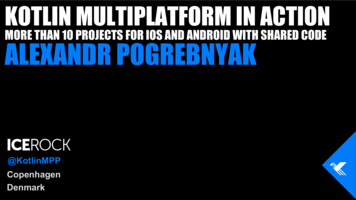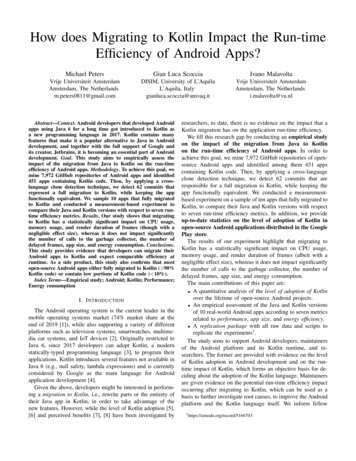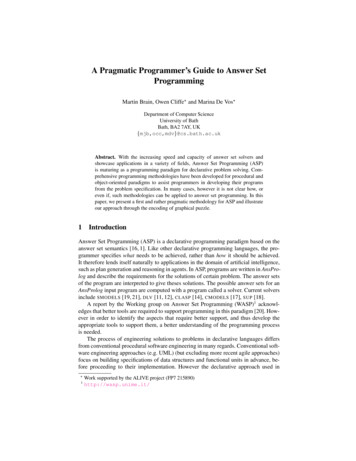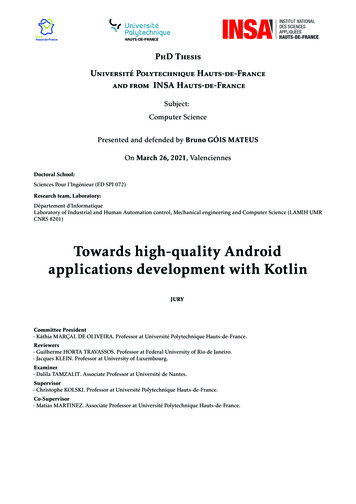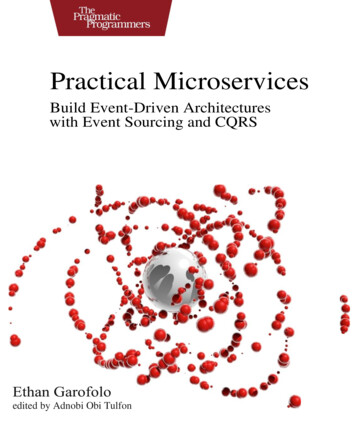
Transcription
Extracted from:Programming KotlinCreating Elegant, Expressive, andPerformant JVM and Android ApplicationsThis PDF file contains pages extracted from Programming Kotlin, published by thePragmatic Bookshelf. For more information or to purchase a paperback or PDFcopy, please visit http://www.pragprog.com.Note: This extract contains some colored text (particularly in code listing). Thisis available only in online versions of the books. The printed versions are blackand white. Pagination might vary between the online and printed versions; thecontent is otherwise identical.Copyright 2019 The Pragmatic Programmers, LLC.All rights reserved.No part of this publication may be reproduced, stored in a retrieval system, or transmitted,in any form, or by any means, electronic, mechanical, photocopying, recording, or otherwise,without the prior consent of the publisher.The Pragmatic BookshelfRaleigh, North Carolina
Programming KotlinCreating Elegant, Expressive, andPerformant JVM and Android ApplicationsVenkat SubramaniamThe Pragmatic BookshelfRaleigh, North Carolina
Many of the designations used by manufacturers and sellers to distinguish their productsare claimed as trademarks. Where those designations appear in this book, and The PragmaticProgrammers, LLC was aware of a trademark claim, the designations have been printed ininitial capital letters or in all capitals. The Pragmatic Starter Kit, The Pragmatic Programmer,Pragmatic Programming, Pragmatic Bookshelf, PragProg and the linking g device are trademarks of The Pragmatic Programmers, LLC.Every precaution was taken in the preparation of this book. However, the publisher assumesno responsibility for errors or omissions, or for damages that may result from the use ofinformation (including program listings) contained herein.Our Pragmatic books, screencasts, and audio books can help you and your team createbetter software and have more fun. Visit us at https://pragprog.com.The team that produced this book includes:Publisher: Andy HuntVP of Operations: Janet FurlowManaging Editor: Susan ConantDevelopment Editor: Jacquelyn CarterCopy Editor: Sakhi MacMillanIndexing: Potomac Indexing, LLCLayout: Gilson GraphicsFor sales, volume licensing, and support, please contact support@pragprog.com.For international rights, please contact rights@pragprog.com.Copyright 2019 The Pragmatic Programmers, LLC.All rights reserved. No part of this publication may be reproduced, stored in a retrieval system,or transmitted, in any form, or by any means, electronic, mechanical, photocopying, recording,or otherwise, without the prior consent of the publisher.ISBN-13: 978-1-68050-635-8Encoded using the finest acid-free high-entropy binary digits.Book version: P1.0—September 2019
Ah, Kotlin—that’s an island off St. Petersburg, Russia, but this book is aboutits namesake programming language. Programmers who use Kotlin don’t justlike the language—they say they love it. What are the reasons for such affection? That’s the question we’ll quickly start with. Then we’ll be on our way toinstall the Kotlin Software Developer Kit (SDK), write some code, and compileand execute it so we can see it working.Imagine taking the best of many different languages—C , C#, Erlang, Groovy,Java, JavaScript, Python, Ruby, Scala, Smalltalk—throwing them into ablender and turning it on; the resulting cocktail is Kotlin. The strength ofKotlin is in its diversity.Andrey Breslav1 and the team of developers behind the language at JetBrains2set out to create a fluent, expressive, pragmatic, and easy to use languagethat is less verbose than many mainstream languages. As programmers pickup Kotlin, they quickly recognize good parts of their familiar languages and,at the same time, are intrigued by other awesome capabilities they’ve notbeen exposed to before. The familiar ideas in Kotlin makes programmers feelat home as they learn and adopt the language, yet the ideas that are new tothem make them more productive compared to the languages they’re usedto. That’s part of the reason why programmers are passionate about Kotlin.The biggest uptick in interest for Kotlin came right after Google’s announcement that Kotlin is an official language for Android development.3 Anendorsement from Google is certainly significant, but there are more reasonsto be excited about Kotlin.Kotlin is one of the few languages that can be used for server-side,mobile/Android, and front-end development. Code, written appropriately,can compile down to Java bytecode or may be transpiled (compiled from thesource code of one language to the source code of another language) toJavaScript. Kotlin/Native supports targeting platforms, including iOS, macOS,Linux, Windows, and WebAssembly, to compile your source code to nativebinaries. That makes Kotlin one of the few languages you can use for fullstack development.As you journey through Kotlin, you may recognize a number of these featuresand trace their in Click HERE to purchase this book now. discuss
2 Though syntactically different, Kotlin is semantically similar to Java,making it easy for Java programmers to adapt. Without inheriting from a class, you may add your own domain-specificconvenience methods to classes. These methods, called extension functions, may be used just like methods that are part of the original class,with full integrated development environment (IDE) support. That’s likeC#-style extension methods in Kotlin, although Kotlin has much richercapabilities. Delegation is often a better design tool than inheritance to reuse code.Kotlin, inspired by languages like Groovy and Ruby, is versatile in theways you can delegate method calls from one object to another, withoutcompromising type safety. You can use the concise and elegant argument-matching syntax in Kotlin,which is similar to Erlang and Scala syntax, instead of the more verboseseries of nested if-else statements. Extending existing functions and methods is easy in Kotlin (though itrequires recompilation due to binary incompatibility), thanks to its defaultparameters’ capabilities, similar to JavaScript, Scala, Ruby, and Python. Named arguments, like in Groovy, Scala, and Ruby, make the code highlyexpressive, easier to read, and less error prone. Where it makes sense, you may overload operators on your own classesor on third-party classes, much like in languages like C and Groovy. The elegance, fluency, and concise nature of Kotlin comes together tosupport creating internal DSLs, similar to languages like Groovy andRuby, but with full support for static type checking. You can write C-style procedures, Scala-style scripts, Java-like OO code,and Smalltalk/Erlang-like functional-style code in Kotlin. Kotlin is leading innovation in the area of asynchronous programmingwith coroutines and continuations.These are just a few of the significant features that are prominent in Kotlin.Reasons to Love KotlinOnce you dig in, Kotlin feels more like a Swiss Army knife than a cocktail—youcan do so much with this language with so little code. The language supportsmultiple paradigms. It’s statically typed with a healthy dose of strong typeinference. It may be compiled to Java bytecode, transpiled to JavaScript, or Click HERE to purchase this book now. discuss
Reasons to Love Kotlin 3it may target native binaries using Kotlin/Native. It is highly fluent and elegant, and it’s a charm to work with. Let’s further explore the reasons to adoptKotlin.Multi-Paradigm ProgrammingKotlin treats us like an adult, it offers choices and lets us pick the approachthat’s best suited for the problem at hand. The language has few ceremonies;you’re not required to write everything in classes nor are you required tocompile every piece of code. The language is largely unopinionated and offersdifferent programming paradigms for you to choose or even intermix.You can see the different programming paradigms supported in Kotlin in thefollowing figure.Elegant andAsynchronousObject-Oriented ngYou can write procedural code—that is, code and functions directly in afile—like in JavaScript or C, and you can run it as a script, without any extracompilation steps, but with the exceptional type safety you expect from astatically typed language. The benefit is that you can do rapid prototyping ofyour ideas or illustrate how a particular design pattern may be used, butwithout being drowned in the ceremonies that other languages often impose.That gives you the shortest time from idea to demo.Much like in Java, you can create classes and write object-oriented code inKotlin, but without much boilerplate code. Thus, it takes less code to achievethe same results as in Java. Kotlin guides you along to create your hierarchyof classes intentionally rather than accidentally. Classes are final by default,and if you intend a class to serve as a base class, you must specify thatexplicitly. Also, delegation has a language-level syntax, so we can select prudently between inheritance and delegation.Though the mainstream world has predominantly used the imperative styleof programming, code written using the functional style is less complex, moreexpressive, concise, elegant, and fluent. Kotlin provides exceptional support Click HERE to purchase this book now. discuss
4for both the imperative and functional style of programming. You can readilybenefit from the key functional capabilities you’re used to from other languagesthat support the paradigm.You can make immediate use of the elegance and low ceremony of Kotlinsyntax to create internal domain-specific languages (DSLs). In addition tocreating your own fluent APIs, you can also benefit from fluency in a numberof different libraries, for example the Kotlin API for the Spring framework.4In addition to programming concurrency using the Java Development Kit(JDK), you may also write asynchronous programs using Kotlin’s coroutines.This feature is critical for applications that make use of cloud services or aredeployed as microservices; it allows you to interact efficiently with other services to exchange data asynchronously.Statically Typed with Type InferenceStatically typed languages offer compile-time type safety, but Kotlin walks afew extra miles to prevent common errors that are likely in other staticallytyped languages. For instance, the Kotlin type system distinguishes nullabletypes from non-nullable types. It also has very strong type inference, in thesame vein of languages like Scala, F#, and Haskell. You don’t have to spendyour time keying in type details that are obvious to everyone looking at thecode. At the same time, when the type may not be 100 percent clear, Kotlinrequires that you specify it. It’s not overly zealous—it supports type inferenceto the right measure, so we can be productive and at the same time the codecan be type safe.One Language for Full-Stack DevelopmentJust like javac compiles Java source code to bytecode to run on the Java Virtual Machine (JVM), kotlinc-jvm compiles the Kotlin code to bytecode to run onvirtual machines. You can write your server-side code and Android applicationsusing Kotlin, and target the specific version of the virtual machine that you’dlike to use for deployment. Thus your Spring code on the back end and yourAndroid or iOS native code on the devices all may be written using the samelanguage. Where necessary, you may also intermix Kotlin code with Javacode—no legacy code has to be left behind.Kotlin also transpiles to JavaScript. You can write Kotlin code that maytransform to JavaScript and run in Node.js on the server side, or in browserson the web front mework-5-kotlin-apis-the-functional-way Click HERE to purchase this book now. discuss
Why Should You Choose Kotlin? 5Using Kotlin/Native, you can compile code to native binary to run on targetedplatforms and to WebAssembly to run within browsers.Fluent and ElegantSome languages impose high ceremony and force you to create boilerplatecode. Some developers argue that IDEs remove the burden of having to writethat code manually. True, but even if the IDEs were to vomit that boilerplatecode, your team has to spend the time and effort maintaining that code eachday. Languages like Scala, Groovy, and Ruby synthesize code that programmers will have to otherwise write. Likewise, Kotlin creates a few things foryou, like fields, getters, and setters, implicitly following the JavaBean convention. Less effort, better results.Kotlin makes a few things optional. For example, a semicolon is optional. Nothaving to place the ; symbol leads to a more fluent syntax—a must for creatingeasy-to-read internal DSLs. Kotlin also provides an infix annotation that wecan use, making the dot and parenthesis optional. With these capabilitiesyou can write fluent and elegant code like this:operate robot {turn leftturn rightmove forward}Yes, it’s not some fiction—that’s real Kotlin code; you’ll learn to create yourown fluent code like this later in the book, without the need for any parsersor external tools.Why Should You Choose Kotlin?Kotlin may be the right choice for your current project, or the next one, formany reasons: Kotlin delivers on the “less is more” promise—you write less boilerplatecode. The less code you write, the less your team has to maintain,resulting in fewer errors to deal with. Kotlin gives you the freedom to mix the imperative and functional stylesof programming; you pick what’s best for the problem at hand. Also, youmay write it in one way and refactor it later as you desire—make it work,then make it better real soon. Kotlin offers lots more compile-time safety when compared to a lot ofother statically typed languages. The code you write will fail less and fail Click HERE to purchase this book now. discuss
6fast—during compilation rather than runtime. This is one of the reasonswhy the Spring5 team decided to embrace Kotlin. Kotlin coroutines makes it a lot easier to create high-performance asynchronous code, compared to what’s available in the Java Development Kit. Some of the features that are scheduled to appear in future versions ofJava are already in Kotlin—you can experience and benefit from futureJava right now by using Kotlin. You may intermix Kotlin and Java code in your projects—using Kotlin isnot an all-or-nothing proposition. You can not only use fluent DSL-like syntax to interact with APIs, like inthe Spring Kotlin API, but also design your own APIs to be fluent andexpressive for programmers who use your code. You can reduce duplication among parts of your system with Kotlin. Forexample, the same business rules that check users’ input may be compiledto Java bytecode for back-end validations, transpiled to JavaScript forfront-end validation, compiled to native binaries to run on targeted platforms like iOS and Android, or to WebAssembly to run within browsers. Finally, Kotlin is a great choice for Android development since it’s anofficial language for that platform.You’ll see more about why Kotlin is exciting in the many pages of this book.Buckle up—it’s going to be a fun ride. Let’s start by getting the SDK installedso we can start writing cing-kotlin-support-in-spring-framework-5-0 Click HERE to purchase this book now. discuss
Where those designations appear in this book, and The Pragmatic Programmers, LLC was aware of a trademark claim, the designations have been printed in initial capital letters or in all capitals. The Pragmatic Starter Kit, The Pragmatic Programmer, Pragmatic Programming, Pragmati

